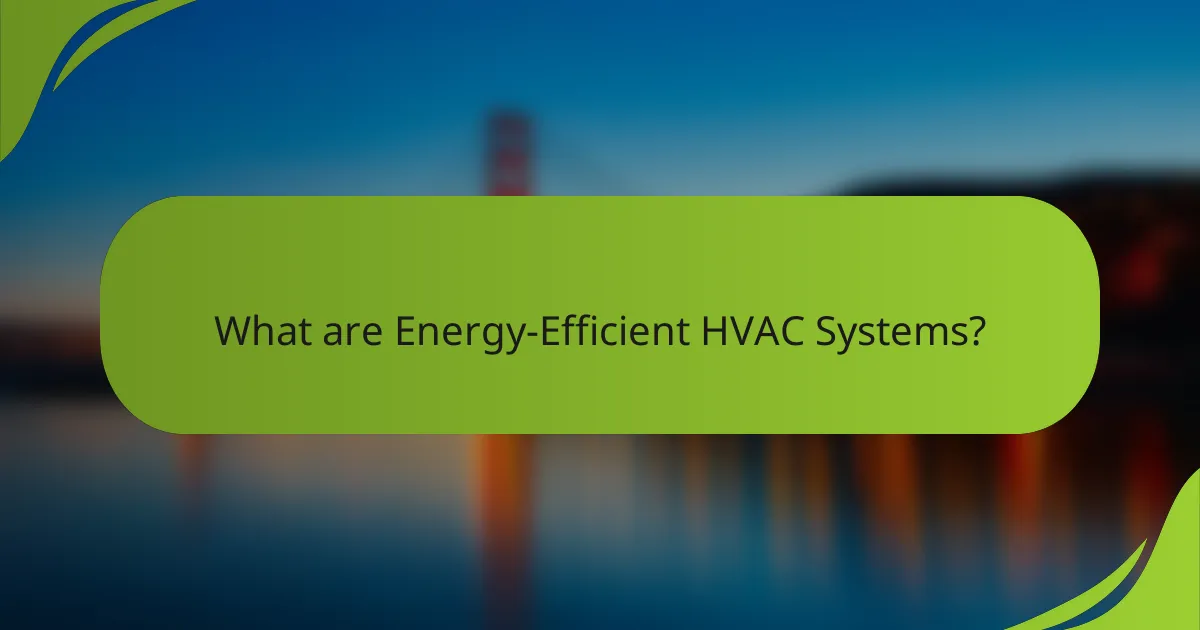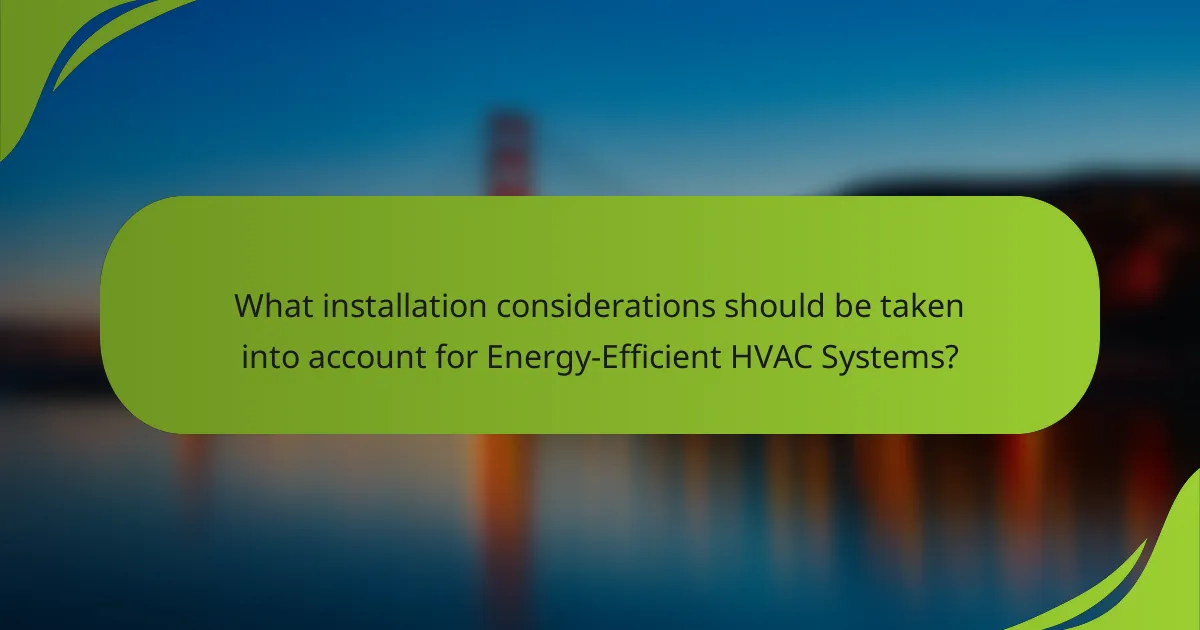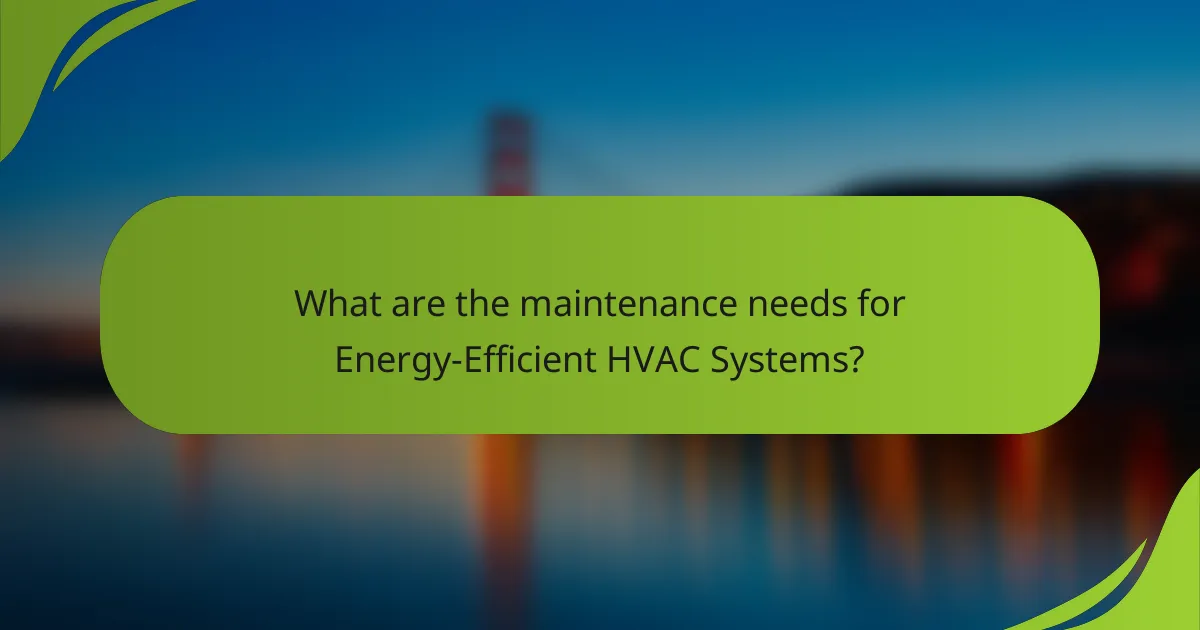Energy-efficient HVAC systems are advanced heating, ventilation, and air conditioning solutions designed to minimize energy consumption while ensuring comfort. These systems feature technologies such as variable-speed motors, programmable thermostats, and high Seasonal Energy Efficiency Ratio (SEER) ratings, leading to potential energy cost reductions of 20% to 50%. Proper installation is critical, requiring accurate sizing, well-sealed ductwork, and strategic placement to enhance performance. Regular maintenance practices, including filter changes, duct inspections, and professional evaluations, are essential to sustain efficiency and prolong system lifespan. Collectively, these elements contribute significantly to energy savings and environmental sustainability.

What are Energy-Efficient HVAC Systems?
Energy-efficient HVAC systems are heating, ventilation, and air conditioning systems designed to use less energy while maintaining comfort. They incorporate advanced technology to optimize energy consumption. These systems often include features such as variable-speed motors, programmable thermostats, and high SEER (Seasonal Energy Efficiency Ratio) ratings. According to the U.S. Department of Energy, energy-efficient HVAC systems can reduce energy costs by 20% to 50%. These systems also contribute to lower greenhouse gas emissions, promoting environmental sustainability.
How do Energy-Efficient HVAC Systems differ from traditional systems?
Energy-efficient HVAC systems utilize advanced technology to reduce energy consumption compared to traditional systems. They often include variable speed motors, which adjust airflow based on demand. This leads to less energy waste and improved efficiency. Traditional systems typically operate at a constant speed, consuming more energy regardless of the heating or cooling needs. Energy-efficient systems also feature better insulation and advanced refrigerants. These components enhance performance and reduce environmental impact. According to the U.S. Department of Energy, energy-efficient HVAC systems can save homeowners up to 30% on energy bills. This demonstrates their effectiveness in providing cost savings while maintaining comfort.
What technologies make HVAC systems energy-efficient?
Energy-efficient HVAC systems utilize several technologies to reduce energy consumption. Variable speed motors adjust airflow based on demand, leading to significant energy savings. Smart thermostats optimize heating and cooling schedules, reducing unnecessary energy use. High-efficiency filters improve air quality while allowing systems to operate more efficiently. Ductless mini-split systems eliminate energy loss associated with ductwork. Geothermal heat pumps leverage stable ground temperatures for efficient heating and cooling. Energy recovery ventilators (ERVs) exchange stale indoor air with fresh outdoor air while minimizing energy loss. These technologies contribute to lower energy bills and reduced environmental impact.
What are the key components of an energy-efficient HVAC system?
The key components of an energy-efficient HVAC system include a high-efficiency furnace or heat pump, programmable thermostats, and advanced ductwork. A high-efficiency furnace typically has an Annual Fuel Utilization Efficiency (AFUE) rating of 90% or higher. This means it converts 90% of its fuel into heat. Heat pumps provide both heating and cooling, using less energy than traditional systems. Programmable thermostats optimize energy use by adjusting temperatures based on occupancy. Advanced ductwork minimizes air leaks and improves airflow efficiency. Energy-efficient units often use variable-speed motors for better performance. These components collectively reduce energy consumption and enhance comfort.
Why are Energy-Efficient HVAC Systems important?
Energy-efficient HVAC systems are important because they significantly reduce energy consumption. These systems lower utility bills by using advanced technology to optimize heating and cooling. According to the U.S. Department of Energy, energy-efficient HVAC systems can save homeowners 20-50% on energy costs. They also contribute to environmental sustainability by decreasing greenhouse gas emissions. Furthermore, these systems enhance indoor air quality by using better filtration methods. This leads to healthier living spaces for occupants. Overall, energy-efficient HVAC systems provide both economic and environmental benefits.
How do these systems contribute to energy conservation?
Energy-efficient HVAC systems contribute to energy conservation by optimizing heating and cooling processes. They utilize advanced technology to maintain desired indoor temperatures with less energy consumption. For example, variable speed motors adjust airflow based on demand, reducing energy use. Programmable thermostats enable users to schedule temperature changes, minimizing energy waste when spaces are unoccupied. Additionally, these systems often include better insulation and sealing, which prevents energy loss. According to the U.S. Department of Energy, upgrading to energy-efficient HVAC can reduce energy consumption by 20-50%. This significant reduction demonstrates their effectiveness in conserving energy.
What impact do they have on environmental sustainability?
Energy-efficient HVAC systems positively impact environmental sustainability. They reduce energy consumption, leading to lower greenhouse gas emissions. According to the U.S. Department of Energy, these systems can decrease energy use by 30-50%. This reduction contributes to less reliance on fossil fuels. Consequently, it helps mitigate climate change effects. Additionally, energy-efficient systems often utilize eco-friendly refrigerants. These refrigerants have lower global warming potential. Therefore, their use further supports environmental sustainability goals.
What are the benefits of Energy-Efficient HVAC Systems?
Energy-efficient HVAC systems reduce energy consumption and lower utility bills. They can save homeowners up to 30% on heating and cooling costs. These systems often qualify for tax credits and rebates, making them financially appealing. They also provide improved indoor air quality through better filtration. Enhanced comfort is achieved by maintaining consistent temperatures. Energy-efficient models typically have a longer lifespan, reducing replacement frequency. Additionally, they contribute to a smaller carbon footprint, promoting environmental sustainability.
How do they affect utility bills for homeowners and businesses?
Energy-efficient HVAC systems significantly reduce utility bills for homeowners and businesses. They use advanced technology to optimize energy consumption. This results in lower electricity and heating costs. For example, Energy Star-rated systems can save up to 30% on energy bills compared to standard models. Additionally, these systems often feature programmable thermostats, which further enhance efficiency by adjusting temperatures based on occupancy. The initial investment in energy-efficient HVAC systems is often offset by long-term savings. According to the U.S. Department of Energy, upgrading to energy-efficient systems can lead to substantial savings over their lifespan. Homeowners and businesses benefit from both reduced costs and improved comfort.
What health benefits are associated with using energy-efficient systems?
Energy-efficient systems provide several health benefits. They improve indoor air quality by reducing pollutants and allergens. This leads to fewer respiratory issues among occupants. Energy-efficient systems also maintain consistent temperatures, enhancing comfort levels. Comfortable environments can decrease stress and promote better mental health. Additionally, these systems often utilize advanced filtration, capturing more dust and allergens. Improved air quality can result in fewer sick days and increased productivity. Studies show that better air quality correlates with overall health improvements.

What installation considerations should be taken into account for Energy-Efficient HVAC Systems?
Proper installation of energy-efficient HVAC systems requires careful consideration of several factors. First, the system’s size must match the building’s heating and cooling requirements. Oversized or undersized systems can lead to inefficiencies and increased energy costs. Second, ductwork must be properly sealed and insulated to prevent air leaks. Leaky ducts can significantly reduce system efficiency.
Additionally, the installation location is crucial. Systems should be placed in areas with adequate airflow and away from obstructions. This ensures optimal performance and longevity. Furthermore, the use of programmable thermostats can enhance energy efficiency. They allow for better temperature control based on occupancy patterns.
Finally, hiring qualified professionals for installation is essential. Proper installation techniques can maximize system efficiency and effectiveness. According to the U.S. Department of Energy, correct installation can improve HVAC efficiency by up to 30%. These considerations collectively contribute to the overall performance and energy savings of HVAC systems.
How do you choose the right size for an energy-efficient HVAC system?
To choose the right size for an energy-efficient HVAC system, assess the square footage of the space. Calculate the heating and cooling load using the Manual J calculation method. This method considers factors like insulation, windows, and climate. Ensure the system has the appropriate BTU (British Thermal Unit) rating for optimal efficiency. An oversized system leads to short cycling, while an undersized system struggles to maintain temperature. Proper sizing enhances comfort and reduces energy costs. According to the U.S. Department of Energy, correctly sized HVAC systems operate more efficiently and last longer.
What factors influence the sizing of HVAC systems?
The sizing of HVAC systems is influenced by several key factors. The first factor is the square footage of the space being conditioned. Larger spaces require more heating or cooling capacity. Next, the insulation quality of the building affects the system size. Well-insulated buildings retain temperature better, potentially reducing system requirements.
The number of windows and their efficiency also play a role. More windows or less efficient windows can increase heating and cooling needs. Additionally, the local climate impacts sizing decisions. Areas with extreme temperatures may require larger systems for adequate comfort.
Occupancy levels are another important factor. More occupants generate additional heat, necessitating a larger system. Finally, the type of HVAC system selected can influence sizing. Different systems have varying efficiencies and capacities.
These factors collectively determine the appropriate size of an HVAC system to ensure optimal performance and energy efficiency.
How can improper sizing affect system performance?
Improper sizing can significantly degrade system performance. An oversized HVAC system may lead to short cycling, where the unit frequently turns on and off. This results in inefficient energy use and increased wear on components. Conversely, an undersized system struggles to maintain desired temperatures, leading to increased energy consumption and discomfort. According to the U.S. Department of Energy, improperly sized systems can reduce efficiency by up to 30%. Proper sizing ensures optimal airflow, temperature control, and energy efficiency.
What are the common installation practices for Energy-Efficient HVAC Systems?
Common installation practices for energy-efficient HVAC systems include proper sizing and load calculation. Accurate load calculations ensure the system meets the specific heating and cooling needs of the space. Installation should also involve sealing ductwork to prevent air leaks. This enhances system efficiency and reduces energy loss.
Using high-quality insulation in ductwork and around the HVAC unit is essential. This minimizes heat transfer and maintains desired temperatures. Another practice is the placement of the outdoor unit in a shaded area. This helps improve efficiency by reducing the workload on the system.
Proper installation of programmable thermostats is also crucial. These devices optimize energy use by adjusting temperatures based on occupancy patterns. Finally, regular maintenance checks after installation help ensure long-term efficiency and performance. Following these practices can lead to significant energy savings and improved indoor comfort.
How does proper ductwork installation impact efficiency?
Proper ductwork installation significantly enhances HVAC system efficiency. Well-designed ductwork minimizes air leaks and ensures optimal airflow. This results in reduced energy consumption. According to the U.S. Department of Energy, improperly sealed ducts can waste 20% to 30% of energy used for heating and cooling. Proper installation also maintains consistent temperatures throughout the space. This prevents overworking the HVAC system, extending its lifespan. Additionally, efficient ductwork reduces noise levels associated with airflow. Overall, proper ductwork installation is crucial for maximizing HVAC efficiency and minimizing operational costs.
What role does system placement play in overall performance?
System placement significantly impacts the overall performance of energy-efficient HVAC systems. Proper placement ensures optimal airflow and temperature distribution throughout a space. When an HVAC system is strategically located, it can reduce energy consumption by minimizing the distance air must travel. For example, systems placed near exterior walls may face challenges due to temperature fluctuations. Additionally, correct placement can enhance system efficiency by preventing overheating or overcooling in specific areas. Studies show that well-placed systems can improve energy efficiency by up to 30%. This highlights the importance of considering system placement during installation for maximizing performance.

What are the maintenance needs for Energy-Efficient HVAC Systems?
Energy-efficient HVAC systems require regular maintenance to ensure optimal performance. Key maintenance needs include changing or cleaning filters every one to three months. This improves airflow and efficiency. Additionally, checking and sealing ductwork is essential to prevent energy loss. Inspecting and cleaning coils annually enhances heat exchange efficiency. Regularly checking refrigerant levels is crucial for system performance. Scheduling professional inspections at least once a year can identify potential issues early. Lubricating moving parts reduces wear and tear, extending the system’s lifespan. Lastly, monitoring thermostat settings ensures accurate temperature control. These practices collectively enhance energy efficiency, leading to lower utility costs.
How often should energy-efficient HVAC systems be serviced?
Energy-efficient HVAC systems should be serviced at least once a year. Regular maintenance ensures optimal performance and extends the system’s lifespan. Seasonal servicing is ideal, typically before the heating or cooling season begins. This practice helps identify potential issues early. Consistent servicing can improve energy efficiency by up to 15%. Additionally, many manufacturers recommend annual inspections to maintain warranty coverage. Regular maintenance includes checking filters, ducts, and refrigerant levels. This proactive approach prevents costly repairs and enhances indoor air quality.
What specific maintenance tasks are essential for these systems?
Essential maintenance tasks for energy-efficient HVAC systems include regular filter replacement, system cleaning, and checking refrigerant levels. Replacing filters every one to three months ensures optimal airflow and system efficiency. Cleaning coils and fins at least once a year prevents dirt buildup that can hinder performance. Checking refrigerant levels annually helps maintain system efficiency and prevents overworking the compressor. Inspecting ductwork for leaks also enhances energy efficiency. Additionally, scheduling professional maintenance biannually can identify potential issues early, ensuring the system operates efficiently. These tasks contribute to prolonged system life and energy savings.
How can regular maintenance enhance system longevity and efficiency?
Regular maintenance enhances system longevity and efficiency by ensuring optimal performance and preventing breakdowns. Routine checks can identify issues before they escalate into costly repairs. For instance, cleaning filters improves airflow, which can increase energy efficiency by up to 15%. Additionally, lubricating moving parts reduces friction, prolonging the life of components. Regular inspections can also help maintain refrigerant levels, which is crucial for efficient cooling. Studies show that well-maintained HVAC systems can last 15-20 years, compared to 10-15 years for those neglected. This proactive approach ultimately saves money on energy bills and extends the system’s operational lifespan.
What troubleshooting tips can help maintain Energy-Efficient HVAC Systems?
Regularly check and replace air filters to maintain energy-efficient HVAC systems. Clogged filters restrict airflow and reduce efficiency. Inspect the thermostat settings to ensure proper operation. Incorrect settings can lead to unnecessary energy consumption. Clean the outdoor unit to remove debris that can obstruct airflow. A clean unit operates more efficiently. Schedule annual professional maintenance to identify potential issues early. Regular check-ups can prevent costly repairs. Monitor energy bills for unusual spikes that may indicate system problems. Addressing these issues promptly can enhance system performance and longevity.
What are common issues faced with energy-efficient HVAC systems?
Common issues faced with energy-efficient HVAC systems include higher upfront costs, complex installation requirements, and maintenance challenges. These systems often require specialized knowledge for proper installation. Inadequate installation can lead to inefficiencies and performance problems. Additionally, energy-efficient systems may be incompatible with older ductwork. Some users report difficulty in finding replacement parts. Limited options for repairs can also arise due to advanced technology. Moreover, these systems may struggle in extreme weather conditions. Regular maintenance is essential to ensure optimal performance and longevity.
How can users identify and resolve minor problems?
Users can identify and resolve minor problems in energy-efficient HVAC systems by observing unusual noises, inconsistent temperatures, or increased energy bills. Regularly checking air filters for dirt and blockages is essential. Users should also inspect thermostats to ensure they are functioning correctly. Cleaning the outdoor unit of debris can improve performance. If issues persist, consulting the user manual can provide specific troubleshooting steps. Additionally, maintaining a schedule for professional inspections can prevent minor issues from escalating. These practices help ensure the system operates efficiently and effectively.
Energy-efficient HVAC systems are advanced heating, ventilation, and air conditioning solutions designed to optimize energy consumption while maintaining comfort. This article covers the key features, technologies, and components that differentiate energy-efficient systems from traditional ones, highlighting their benefits such as significant energy cost savings, improved indoor air quality, and reduced greenhouse gas emissions. It also addresses installation considerations, proper sizing, maintenance needs, and common troubleshooting tips to ensure optimal performance and longevity of these systems. Overall, energy-efficient HVAC systems represent a sustainable choice for both economic and environmental benefits.